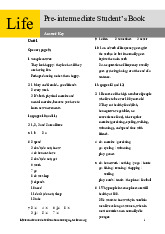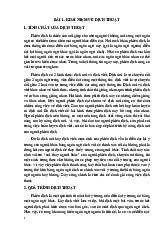





Preview text:
LESSON PLAN
TIẾNG ANH 11 FRIENDS GLOBAL UNIT 1: GENERATIONS
LESSON 1C- LISTENING: FAMILY TENSIONS I. OBJECTIVES
By the end of this lesson, Ss will be able to: 1. Knowledge
- Identify the attitude and intention of a speaker through tone of voice.
- Gain vocabulary to talk about family arguments. 2. Competences
- Develop communication skills and creativity.
- Be collaborative and supportive in pair work and teamwork.
- Actively join in class activities. 3. Personal qualities
- Understand the effect of technology on family life. - Develop self-study skills. II. MATERIALS
- Grade 11 textbook, Unit 1, Listening
- Computer connected to the Internet
- Projector / TV/ pictures and cards
- Phần mềm tương tác sachso.vn Language analysis Form Pronunciation Meaning
unhappy because you feel that you have been 1. bitter (adj) /ˈbɪtə(r)/ treated unfairly 2. complimentary (adj) /ˌkɒmplɪˈmentri/
expressing approval, praise, etc.
having or bringing a sad feeling mixed with 3. nostalgic (adj) /nɒˈstældʒɪk/
pleasure when you think of happy times in the past
showing or expressing in a way opposite to what 4. sarcastic (adj) /sɑːˈkæstɪk/
you mean in order to be unpleasant to somebody or to make fun of them
showing that you think that something needs to 5. urgent (adj) /ˈɜːdʒənt/ be dealt with immediately Assumption
Anticipated difficulties Solutions
- Encourage students to work in pairs and in groups so
Students are reluctant to work in
that they can help each other. groups.
- Provide feedback and help if necessary.
- Explain expectations for each task in detail.
- Continue to explain task expectations in small
chunks (before every activity).
Students may lack vocabulary to deliver - Provide vocabulary and useful language before a speech assigning tasks
- Encourage students to work in groups so that they can help each other. III. PROCEDURES 1. WARM-UP (3 mins) a. Objectives:
- Introduce the new lesson and set the scene for Ss to acquire new language.
- Get students' attention at the beginning of the class by means of enjoyable and short
activities as well as to engage them in the steps that followed. b. Content: - Exercise 1. (p.15) c. Expected outcomes:
- Students can gain more confidence and interest in the lesson. d. Organisation
TEACHER’S AND STUDENTS’ ACTIVITIES CONTENTS
Exercise 1: Work in pairs. Look at the photo. What do you think this app does? Why might some people need it? (3 mins)
- Students look at the photo and discuss the questions. Suggested Answers:
- T asks a few students to share their ideas with the class The app allows parents to lock their
children’s phones at times when they should
be doing other things such as studying.
some children might need this app because
they spend too much time on their phones
instead of doing other things. e. Assessment
- Teacher observes the groups and give feedback.
2. ACTIVITY 1: PRESENTATION (15 mins) a. Objectives:
- To get students learn vocabulary related to the topic. b. Content:
- Pre-teach vocabulary related to the topic. - Exercise 2 (p.15) - Exercise 3 (p.15) c. Expected outcomes:
- Ss know how to pronounce the new words precisely and use them in appropriate contexts.. d. Organisation
TEACHER’S AND STUDENTS’ ACTIVITIES CONTENTS
Vocabulary pre-teaching (4 mins) New words:
- Teacher introduces the vocabulary. 1. bitter (adj)
- Teacher explains the meaning of the new vocabulary 2. complimentary (adj) by pictures. 3. nostalgic (adj)
- Teacher checks students’ understanding. 4. sarcastic (adj)
- Teacher reveals that these words will appear in the 5. urgent (adj)
reading text and asks students to open their textbook to discover further.
Exercise 2. Read the text and check your answer to exercise 1. Do you think the app would
increase or decrease the number of arguments in your family? Why? (3 mins)
- Students read the text and check their answer. Suggested Answer:
- Ask a student to summarize the purpose of the app.
I am sure that this app would increase the
- In pairs, students discuss the questions.
number of arguments in my family. Firstly, I
- Ask a few students to share their ideas with the class
do not want my parents to lock my phones
through this app while I am using it. If this
app is on my phones, I will try to delete it.
Secondly, people always want to do
something that they are not allowed to do.
The arguments between my parents and I
can become more seriously. This app is not
suitable to avoid people from using it.
Exercise 3. Match some of the phrases in exercise 2 with the pictures below of the woman at
different stages of her life. (4 mins)
- Check and practice the pronunciation of the adjectives. Answers:
- Students then decide which adjectives describe
• Positive: calm, complimentary,
positive attitudes and which describe negative attitudes.
enthusiastic, grateful, nostalgic,
- Check answers as a class. Point out that nostalgic can optimistic, sympathetic
be positive or negative, depending on the context.
• Negative: accusing, aggressive,
arrogant, bitter, miserable, nostalgic,
pessimistic, sarcastic, urgent
Exercise 4. Read the Listening Strategy. Then listen and underline the adjective which best
matches the speaker’s attitude. Use their tone of voice to help you. (4 mins)
- Go through the Listening Strategy together. Answers: - Elicit ideas. 1 pessimistic
- Play the recording for students to choose the most 2 aggressive appropriate adjective. 3 complimentary - Check answers as a class. 4 sympathetic e. Assessment
- Teacher checks students’ pronunciation and gives feedback.
- Teacher checks students’ understanding of listening strategy.
- Teacher observes Ss’ writing of vocabulary on their notebooks.
3. ACTIVITY 2: PRACTICE (14 mins) a. Objectives:
- Ss can answer the questions to critical thinking.
- They can also finish the tasks in the textbook. b. Content: - Exercise 5. (p.15) - Exercise 6. (p.15) - Exercise 7. (p.15) c. Expected outcomes:
- Students can thoroughly understand the content of the text and complete the tasks successfully. d. Organisation
TEACHER’S AND STUDENTS’ ACTIVITIES CONTENTS
Exercise 5. Listen and compare two different ways of saying the sentences. Then, in pairs, say a
sentence in one of the two ways. Can your partner guess the adjective? (4 mins)
- Go through the instructions together. Students’ performance
- Play the recording for students to listen to the sentences.
- In pairs, they take turns to say the sentences in
one of the two ways. Their partner must guess the correct adjective.
Exercise 6. Work in pairs. Listen to four speakers and decide which speaker sounds urgent/
calm/enthusiastic/arrogant. (5 mins)
- Go through the instructions together. Answer key:
- Play the recording for students to match the speaker 1: b. speakers with the adjectives. speaker 2: c. - Check answers as a class. speaker 3: a. speaker 4: d.
Exercise 7. Listen again. Match sentences A–E with speakers 1–4. Use the tone of voice to help
you. There is one extra sentence. (5 mins)
- Ask students to read the sentences and underline Answer key: key words. speaker 1: c
- Play the recording again for students to match speaker 2: a
each speaker with one of the sentences. speaker 3: d - Check answers as a class. speaker 4: b e. Assessment
- Teacher observation on Ss’ performance.
- Teacher’s feedback and peers’ feedback.
4. ACTIVITY 3: PRODUCTION (10 mins) a. Objectives:
- To help Ss practice speaking skills.
- To help Ss memorize the basic knowledge on family arguments. b. Content:
- Presentation. discussion. - Exercise 7 (p15) c. Expected outcomes:
- Students can give a short talk about family tensions and problems. d. Organisation
TEACHER’S AND STUDENTS’ ACTIVITIES CONTENTS
Exercise 7. Work in pairs. Ask and answer about your family and your ancestors. Give extra
information where you can. (10 mins)
- In pairs, students discuss the topics and decide which
Students’ own creativity.
one causes the most family arguments.
- They then continue to work in their pairs to think of
more topics that cause arguments.
- Ask each pair to share their ideas with the class. Give
the other students the chance to disagree if they have a different opinion.
- Ask students to vote for the topic that causes the most family arguments. e. Assessment
- Teacher observation on Ss’ performance.
- Teacher’s feedback and peers’ feedback. 5. CONSOLIDATION (3 mins) a. Wrap-up
- T asks Ss to talk about what they have learnt in the lesson. b. Homework - Prepare for the next lesson Board Plan Date of teaching
TIẾNG ANH 11 FRIENDS GLOBAL UNIT 1: GENERATIONS
LESSON 1C- LISTENING: FAMILY TENSIONS * Warm-up - Exercise 1 * Vocabulary 1. bitter (adj) 2. complimentary (adj) 3. nostalgic (adj) 4. sarcastic (adj) 5. urgent (adj) * Presentation - Exercise 2 - Exercise 3 - Exercise 4 * Practice - Exercise 5 - Exercise 6 - Exercise 7 * Production - Exercise 8 *Homework




